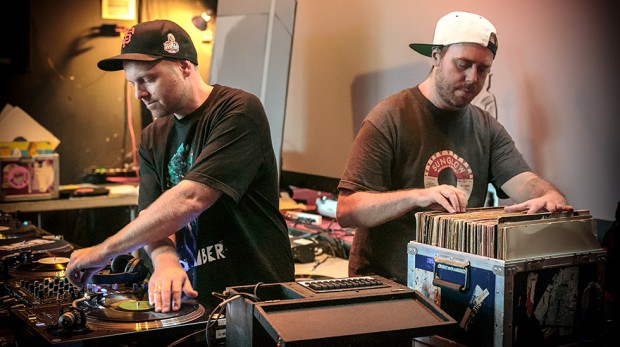
“To me, the gift of Bambaataa is the concept that the world is a vast place and that there’s a lot of music to be discovered,”
The Renegades of Rhythm tour sees DJ Shadow and Cut Chemist celebrate the music of Afrika Bambaataa Metro City this Sunday, March 14. TOM CLIFT reports.
When it comes to the world of hip hop, few names hold more importance than DJ Afrika Bambaataa.
Coming up in the South Bronx in the 1970s, he was influenced by everything from funk and rock music to the philosophies of black liberation. His innovative sets and focus on social issues were groundbreaking for the era, and helped to establish the foundation from which an entire musical culture would grow.
“To me, the gift of Bambaataa is the concept that the world is a vast place and that there’s a lot of music to be discovered,” says the California-based DJ Shadow. “He helped expose a lot of different types of music to the initial generation of B-boys and B-girls, and was a huge influence on other DJs to look to unusual things to add to your set. In the early ’70s and everything prior to that, DJs were expected to cater to the audience and to play things that the audience knew and that the audience was expecting to hear. But Bambaataa, along with Kool Herc, was one of the first people to turn the DJ set into an artistic statement.”
A mainstay of the instrumental hip hop scene himself, DJ Shadow’s upcoming Australian tour, dubbed Renegades Of Rhythm, is a tribute to Bambaataa’s insurmountable legacy. Along with regular collaborator, Cut Chemist, Shadow has constructed a set exclusively from Bambaataa’s personal vinyl collection. The idea is to provide audiences with a kind of aural history of hip hop’s beginnings.
“We were approached by somebody who was basically the middleman for Cornell University and Bambaataa,” DJ Shadow explains. “Bambaataa donated his collection to the hip hop archive at Cornell University in Upstate New York last year, and as the actual records were being collected from various facilities around New York and put into one holding place in Queens, it was this person’s idea that maybe some DJs should give the collection one last spin before it goes off to the Cornell vault.
“Really the show is a celebration of Bambaataa as a DJ, and all the records that he helped bring to the fore of hip hop culture. To me, the collection of records that we play from in the show is as close as you can get to the epicentre of hip hop culture, because they’re the exact same copies that were played in the Bronx in the mid-’70s.
“He would play little spoken word pieces, he would play sound effects, he would play krautrock, he would play weird new wave records and mix that in with his love for funk. He would play salsa and calypso and things like that, and it’s really that aesthetic that I think really attracted that initial wave of downtown New Yorkers to his sets, and helped him gain popularity. People like The Clash and Deborah Harry – what blew their mind about him was this really unorthodox collision of all these different musical styles.”
As Shadow recalls, Bambaataa’s music also had an influence on him personally. “Planet Rock was the second real hip hop song I ever heard,” he says. “I was 10 years old, and it was played by the soul station in San Francisco that I listened to on my little transistor radio. I leaned over and pressed ‘record’ on my portable tape recorder and held it up to the speaker and made a little primitive recording of it. So in terms of my hip hop experience as a youth, Bambaataa was literally there from the beginning. Then once I started buying vinyl, I noticed there were certain names that you always saw thanked on the backs of everyone’s records, from Run-D.M.C. to Kurtis Blow to Whodini. All the artists who had albums out around ’83-’84, they all thanked Bambaataa.”
To construct their set, Shadow and Cut Chemist went through more than 40,000 of Bambaataa’s records. “We kind of whittled it down to about 500 that we then built the set from,” says Shadow. “Obviously you can only play so much music in an hour and 45 minutes. Cut and I talked at length about what we wanted to say and not say. It was kind of hard going through the collection and seeing things that we knew to be rare, and that you know as a collector is worth a tonne of money, and that people would love to hear us play. In the end though, if it didn’t speak to his legacy in any meaningful way then we didn’t play it.
“In a weird way, there are parts of the set where we don’t expect the crowd to necessarily be into it in the same way that they might be into other pivotal parts of the set. It’s more like we just want them to stop and take a breath and think about the magnitude and the depth of what Bambaataa brought to the table. And we feel that those moments are really important. Just like in a good movie – you don’t just want explosions for 95 minutes. There has to be a little bit more to it than that. And we’re proud of those kinds of moments. It’s really satisfying, because at the end of the sets, the audiences just seem to want to applaud for minutes on end, and you really get the impression that they get it; that they’ve been exposed to something that has historical significance.”